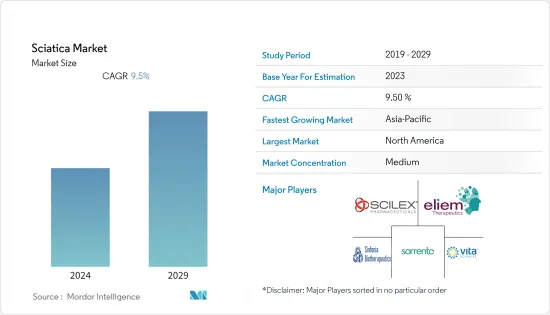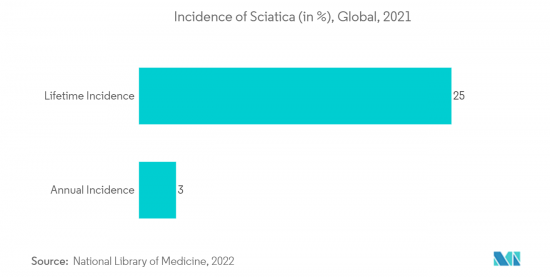
|
市場調査レポート
商品コード
1407001
坐骨神経痛:市場シェア分析、産業動向と統計、2024~2029年の成長予測Sciatica - Market Share Analysis, Industry Trends & Statistics, Growth Forecasts 2024 - 2029 |
||||||
カスタマイズ可能
適宜更新あり
|
|||||||
| 坐骨神経痛:市場シェア分析、産業動向と統計、2024~2029年の成長予測 |
|
出版日: 2024年01月04日
発行: Mordor Intelligence
ページ情報: 英文 111 Pages
納期: 2~3営業日
|
全表示
- 概要
- 目次
坐骨神経痛市場は予測期間中にCAGR 9.5%を記録すると予測されます。

COVID-19の流行は坐骨神経痛市場に大きな影響を与えました。2021年6月にJournal of Pain Researchに掲載された調査によると、退院後、COVID-19感染者の27.3%が関節痛、21.7%が胸痛を訴えました。また、退院から4週間後、病棟で治療を受けた患者の10~20%が筋肉痛に苦しんでおり、ICU入院が必要な患者ではその割合が30%まで増加したことが強調されています。したがって、このような研究により、パンデミックの間、痛みの有病率が高まっていたことが観察され、これは調査した市場にプラスの影響を与えました。しかし、現在、市場はパンデミック前の状態に達しており、今後数年間は力強い成長が見込まれます。
坐骨神経痛患者の再発率が高いことは、坐骨神経痛市場にとってプラスであり、患者が新しい治療法を試すのに役立っています。坐骨神経痛は、坐骨神経痛の原因となった脊椎椎間板がひどく損傷すると再発しやすいです。椎間板の損傷が大きければ大きいほど、再発して再び坐骨神経痛を引き起こす可能性が高くなります。
2022年8月にNational Library of Medicineに発表された研究では、慢性疼痛(6ヶ月以上)の患者は急性疼痛(6ヶ月未満)の患者よりも手術後の転帰が悪かった。75%以上の治癒率を報告した研究もあるが、50%以下の治癒率を報告した研究もあります。坐骨神経痛に対処するための新しい整形外科手術はいくつかあり、これらの手術は短期的には70%以上の成功率を示しています。したがって、整形外科的処置の進歩に伴い、調査された市場は今後数年で成長すると考えられています。
坐骨神経痛の発症に影響すると考えられるいくつかの環境因子や固有因子が研究されており、性別、体格、出産、年齢、遺伝因子、職業、環境因子などが含まれます。例えば、2021年1月に発表されたメイヨークリニックのデータによると、米国では人口の80%が生涯に腰痛を抱えることになると推定されています。このように、坐骨神経痛は慢性的な痛みにつながる最も一般的な疾患の一つであるため、その負担の増大が治療需要の増加につながり、市場の成長に寄与しています。
しかし、適切な診断検査が行われていないことや、適応外投薬が利用可能であることが、市場成長を抑制する要因となっています。
坐骨神経痛市場の動向
非ステロイド性抗炎症薬セグメントは力強い成長が期待される
非ステロイド性抗炎症薬の主な抗炎症、解熱、鎮痛作用は、シクロオキシゲナーゼ(COX)1およびCOX2酵素の抑制に基づいています。COX酵素を阻害することで、血管拡張が抑制され、炎症が緩和されます。非ステロイド性抗炎症薬(NSAIDs)は、坐骨神経痛の治療薬として最も頻繁に処方される薬のひとつです。NSAIDsは承認されつつあり、市場に有利な機会を生み出しています。sciaticapain.co.ukによると、2022年、鎮痛剤はこれらの細胞の産生を止め、脳は体のどこかに痛みがあるというシグナルを出さなくなります。
鎮痛剤と抗炎症剤は、最も多くの薬剤群を構成する最も効果的な薬です。最も一般的なのは、痛み、発熱、筋肉痛、その他の筋骨格系疾患の治療に用いられる抗炎症薬(鎮痛剤)です。医師は、イブプロフェンやタイレノールなど、市販されている低用量の薬を勧める。市販のNSAIDsは痛みを和らげるためのものです。市販薬で効果がない場合は、処方されたNSAIDsが鎮痛のために必要になることもあります。したがって、坐骨神経痛への対処におけるNSAIDsの重要性から、このセグメントは予測期間中に大きく成長すると予想されます。

北米が市場で大きなシェアを占める見込み
北米は、老人人口の増加と腰痛の有病率の増加により、世界の坐骨神経痛市場で大きなシェアを占めると予想されています。National Center for Health Statisticsが発表した調査によると、2021年には米国の成人の約39%が過去3ヶ月以内に腰痛を経験したと回答しています。米国とカナダではヘルスケアの普及が進んでいるため、整形外科手術の件数が多く、坐骨神経痛市場を牽引しています。
さらに、同地域の老人人口の増加は、高齢者層が痛みやその他の筋骨格系障害を起こしやすいことから、調査対象市場の成長に大きな影響を与えると予想されます。例えば、米国国勢調査局の2021年報告書によると、2021年中に5,400万人以上の65歳以上の人々が米国に居住しており、この数は2050年までに8,570万人に達すると予測されており、これは米国の総人口の約20%に相当します。高齢者は坐骨神経痛を発症しやすいため、高齢者人口の増加により研究対象市場の拡大が見込まれています。
さらに、特に米国とカナダにおける医療費の高騰と、この病気に対する意識の高まりが、この地域の市場全体の成長を大きく後押ししています。したがって、前述の要因により、北米地域は予測期間中、坐骨神経痛市場で大きなシェアを占めると予想されます。
坐骨神経痛産業の概要
坐骨神経痛市場は細分化されており、市場競争も激しく、複数の大手企業で構成されています。市場シェアの面では、現在数社の大手企業が市場を独占しています。現在市場を独占している企業には、Sorrento Therapeutics、SpineThera、Eliem Therapeutics、Scilex Holding、Sinfonia Biotherapeutics、生化学工業株式会社、Kolon life Scienceなどがあります。
その他の特典:
- エクセル形式の市場予測(ME)シート
- 3ヶ月間のアナリスト・サポート
目次
第1章 イントロダクション
- 調査の前提条件と市場定義
- 調査範囲
第2章 調査手法
第3章 エグゼクティブサマリー
第4章 市場力学
- 市場概要
- 市場促進要因
- 坐骨神経痛に対する意識の高まりと高い生存率
- 危険因子と高齢者人口の増加
- 市場抑制要因
- 明確な診断基準がないこと
- 市場には適応外薬と理学療法が複数存在する
- ポーターのファイブフォース分析
- 新規参入業者の脅威
- 買い手/消費者の交渉力
- 供給企業の交渉力
- 代替品の脅威
- 競争企業間の敵対関係の強さ
第5章 市場セグメンテーション
- タイプ別
- 急性坐骨神経痛
- 慢性坐骨神経痛
- その他
- 薬理療法別
- 非ステロイド性抗炎症薬(NSAIDs)
- ステロイド
- 抗うつ薬
- 鎮痛剤
- その他
- 地域
- 北米
- 欧州
- アジア太平洋
- 中東・アフリカ
- 南米
第6章 競合情勢
- 企業プロファイル
- Sorrento Therapeutics
- SpineThera
- Eliem Therapeutics
- Scilex Holding
- Sinfonia Biotherapeutics
- Seikagaku Corporation
- Kolon life Science
- Vita Sciences
- Aurobindo Pharma
第7章 市場機会と今後の動向

The Sciatica market is projected to register a CAGR of 9.5% during the forecast period.
The COVID-19 pandemic had a significant impact on the sciatica market. A study published in the Journal of Pain Research in June 2021 showed that after hospital discharge, 27.3% of post-COVID-19 individuals reported joint pain and 21.7% chest pain. Again, it was highlighted that four weeks after discharge from the hospital, 10-20% of patients treated in the ward suffered from myalgia and the percentage increased to up to 30% in those who needed ICU hospitalization. Hence, with such studies, it was observed that there was a growing prevalence of pain during the pandemic which positively impacted the market studied. However, the market studied has reached its pre-pandemic nature currently and is expected to witness strong growth in the coming years.
Certain factors that are driving the market growth include the high recurrence rate of sciatica patients, which proves to be positive upfront for the sciatica market and helps patients to try new interventions. Sciatica is likely to recur if the spinal disc that contributed to Sciatica is severely damaged. The more damaged the disc, the more likely it is to re-herniate and causes Sciatica again.
In a study published in the National Library of Medicine in August 2022, patients with chronic pain (more than six months) had a poorer outcome following surgery than patients with acute pain (less than six months). Some studies reported a cure rate of more than 75%, but other studies report cure rates of less than 50%. There are several newer orthopedic procedures to manage Sciatica, and these procedures have success rates of 70% and above in the short term. Therefore, with the advances in orthopedic procedures, the market studied is believed to grow in the coming years.
Several environmental and inherent factors thought to influence the development of Sciatica have been studied, including gender, body habitus, parity, age, genetic factors, occupation, and environmental factors. For instance, according to Mayo Clinic data published in January 2021, it was estimated that in the United States, 80% of the population will have low back pain in their lifetime. Thus, the increasing burden of Sciatica is leading to increasing demand for its treatment, as it is one of the most common conditions leading to chronic pain, thereby contributing to market growth.
However, the lack of proper diagnostic tests and the availability of off-label medication are some of the factors restraining the market growth.
Sciatica Market Trends
The Non-Steroidal Anti Inflammatory Drug Segment is Expected to Witness a Strong Growth
The main antiinflammatory, antipyretic, and analgesic effect of NSAIDs is based on the suppression of the cyclooxygenase (COX)1 and COX2 enzymes. By blocking the COX enzymes, vasodilation is reduced and inflammation relieved. Non-steroidal antiinflammatory drugs (NSAIDs) are one of the most frequently prescribed drugs for the treatment of sciatica. The products are getting approvals and hence, creating lucrative opportunities in the market. As per sciaticapain.co.uk, 2022, painkillers stop the production of these cells, and the brain stops signaling that there is pain somewhere in the body.
Pain killers and anti-inflammatory medicines are the most effective medicines that make up the most numerous group of drugs. Most commonly, antirheumatics (painkillers) are used to treat pain, fever, muscle pain, and other musculoskeletal disorders. Doctors recommend low-dose medications that can be purchased over the counter, such as Ibuprofen or Tylenol. The over-the-counter NSAIDs are meant to provide pain relief. Prescription NSAIDs may be necessary for pain relief if over-the-counter drugs are ineffective. Therefore, with the significance of NSAIDs in coping with sciatica, the segment is expected to grow significantly in the forecast period.

North America is Expected to Hold a Significant Share in the Market
North America is expected to hold a major market share in the global Sciatica market due to the rise in the geriatric population and the increasing prevalence of lower back pain in this region. As per a study published by National Center for Health Statistics, in 2021, around 39% of adults in the United States stated they had experienced back pain within the past three months. A greater number of orthopedic procedures due to greater healthcare penetration in the United States and Canada drives the sciatica market.
Further, the increasing geriatric population of the region is expected to have a significant impact on the growth of the studied market as the older population is more prone to pain and other musculoskeletal disorders. For instance, according to the 2021 report of the United States Census Bureau, more than 54 million people of age 65 years and above were living in the country during 2021 and this number is projected to reach 85.7 million by 2050, which will be about 20% of the total population of the United States. As old people are prone to develop sciatica, the market studied is expected to grow as a result of the geriatric population increase.
Moreover, high expenditure on healthcare, especially in the United States and Canada, along with increased awareness about the disease, are fueling the growth of the overall regional market to a large extent. Therefore, due to the aforementioned factors, the North American region is expected to hold a significant share of the sciatica market over the forecast period.
Sciatica Industry Overview
The Sciatica market is fragmented, competitive in nature, and consists of several major players. In terms of market share, a few of the major players are currently dominating the market. Some of the companies which are currently dominating the market are Sorrento Therapeutics, SpineThera, Eliem Therapeutics, Scilex Holding, Sinfonia Biotherapeutics, Seikagaku Corporation, Kolon life Science and others.
Additional Benefits:
- The market estimate (ME) sheet in Excel format
- 3 months of analyst support
TABLE OF CONTENTS
1 INTRODUCTION
- 1.1 Study Assumptions and Market Definition
- 1.2 Scope of the Study
2 RESEARCH METHODOLOGY
3 EXECUTIVE SUMMARY
4 MARKET DYNAMICS
- 4.1 Market Overview
- 4.2 Market Drivers
- 4.2.1 Increased Public Awareness and High Survival Rate of Sciatica
- 4.2.2 Risk Factors and Increasing Elderly Population
- 4.3 Market Restraints
- 4.3.1 No Single or Definitive Diagnostic Criteria Available
- 4.3.2 Several Off-Label Drugs and Physical Therapy In Market
- 4.4 Porter's Five Forces Analysis
- 4.4.1 Threat of New Entrants
- 4.4.2 Bargaining Power of Buyers/Consumers
- 4.4.3 Bargaining Power of Suppliers
- 4.4.4 Threat of Substitute Products
- 4.4.5 Intensity of Competitive Rivalry
5 MARKET SEGMENTATION
- 5.1 By Type
- 5.1.1 Acute Sciatica
- 5.1.2 Chronic Sciatica
- 5.1.3 Others
- 5.2 By Pharmacological Therapies
- 5.2.1 Non-Steroidal anti inflammatory drug (NSAIDs)
- 5.2.2 Steroids
- 5.2.3 Antidepressants
- 5.2.4 Painkillers
- 5.2.5 Others
- 5.3 Geography
- 5.3.1 North America
- 5.3.2 Europe
- 5.3.3 Asia-Pacific
- 5.3.4 Middle East and Africa
- 5.3.5 South America
6 COMPETITIVE LANDSCAPE
- 6.1 Company Profiles
- 6.1.1 Sorrento Therapeutics
- 6.1.2 SpineThera
- 6.1.3 Eliem Therapeutics
- 6.1.4 Scilex Holding
- 6.1.5 Sinfonia Biotherapeutics
- 6.1.6 Seikagaku Corporation
- 6.1.7 Kolon life Science
- 6.1.8 Vita Sciences
- 6.1.9 Aurobindo Pharma

